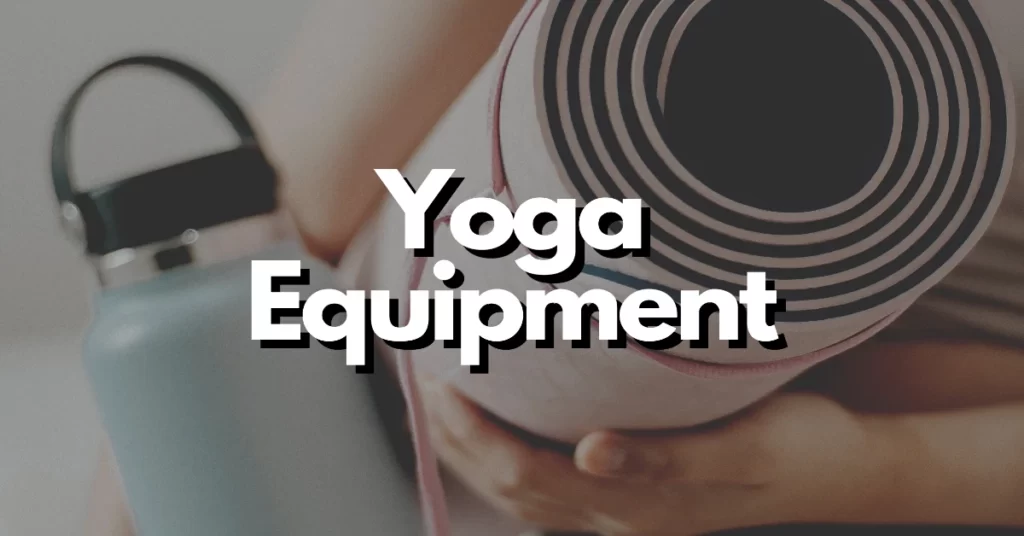The yoga mat is a cornerstone of yoga practice. It provides a stable and comfortable surface for your asanas (poses), ensuring safety and alignment. When choosing a yoga mat, consider factors like thickness, material, and texture. Thicker mats offer more cushioning for your joints, while thinner ones provide better stability.
Many yoga mats are made of PVC, but eco-conscious options crafted from natural rubber, cork, or TPE (Thermoplastic Elastomer) are available. These eco-friendly mats are not only better for the environment but also less likely to emit harmful chemicals.
Caring for your yoga mat is essential to maintain its longevity and hygiene. Regularly clean it with a mild detergent or a mat-specific cleaner, and let it air dry. Roll your mat with the textured side facing out to prevent curling.
Enhancing Your Practice with Yoga Props
Yoga props are valuable tools for practitioners of all levels, helping you deepen stretches, refine alignment, and provide support when needed. Yoga blocks, typically made of foam, cork, or wood, are versatile aids. They can be placed under your hands in standing poses to extend your reach or under your hips in seated poses to improve posture and alignment.
Yoga straps, often made of cotton or nylon, aid in achieving proper alignment and extending stretches. They are particularly useful in poses where you can’t quite reach your feet or need to bridge the gap between your hands. Straps can also be used as aids for balance and stability.
Yoga bolsters, typically cylindrical or rectangular cushions, are fantastic for restorative practices. They provide support in reclining poses, helping you relax and release tension. They can also be used to elevate hips in seated poses, making them more accessible.
Yoga Wheels – Unlocking New Possibilities
Yoga wheels have gained popularity for their ability to deepen stretches, improve flexibility, and enhance core strength. They consist of a sturdy wheel with a padded outer surface. When used correctly, yoga wheels offer a dynamic approach to your practice.
One of the primary benefits of yoga wheels is their ability to provide support and stability in challenging poses. For example, in backbends like Camel Pose or Bridge Pose, the wheel can support your weight and provide a more comfortable and controlled stretch.
Safety is paramount when using yoga wheels. It’s essential to start with basic poses and gradually progress to more advanced ones as you become accustomed to the wheel’s support. Always use the wheel mindfully, and if you have any pre-existing medical conditions or injuries, consult with a yoga instructor or healthcare professional before incorporating a wheel into your practice.
Yoga Accessories – The Finishing Touches
Beyond the core equipment, there are various yoga accessories that can complement your practice. Yoga gloves and socks with non-slip grips can provide extra stability and hygiene, especially in heated yoga classes. They prevent your hands and feet from slipping on the mat, allowing you to maintain a firm grip in poses.
Yoga straps and ropes are essential for deepening stretches, enhancing flexibility, and achieving proper alignment. Straps can be looped around the feet, hands, or body to facilitate various stretches and poses. Ropes, often used in Iyengar yoga, assist in gaining flexibility and balance.
Eye pillows and sandbags are valuable tools for relaxation and stress relief. Placing an eye pillow over your closed eyes during Savasana (Corpse Pose) can help you focus on your breath and block out distractions. Sandbags, when gently placed on specific body parts during restorative poses, add gentle pressure, encouraging relaxation and releasing tension.
Designing Your Sacred Space – Home Yoga Essentials
Creating a dedicated space for your yoga practice at home is a powerful way to deepen your connection to the practice. Select a quiet, clutter-free area where you can unroll your mat without distractions. Ideally, this space should have good ventilation and natural light.
Enhance the ambiance of your yoga space with elements like scented candles, incense, or essential oils. Aromatherapy can evoke calmness and focus during your practice. Choose scents like lavender or eucalyptus for relaxation or citrus scents for invigoration.
Incorporate soothing music or nature sounds to create a tranquil atmosphere. Many streaming platforms offer curated yoga playlists that align with different practice styles. Find the music that resonates with you and enhances your experience.
Yoga Clothing – Comfort, Style, and Functionality
Comfortable clothing is essential for a successful yoga practice. Breathable, moisture-wicking fabrics like cotton, bamboo, or synthetic blends keep you dry and comfortable during your practice.
When selecting yoga attire, consider functionality. Choose clothing that allows for a full range of motion without restricting your movements. Elastic waistbands and stretchy materials are ideal for flexibility and comfort.
In recent years, there has been a growing trend toward sustainable and eco-friendly yoga clothing. These options are made from organic materials and are often produced with environmentally conscious practices, minimizing their impact on the planet.
Storing and Organizing Your Yoga Gear
As you accumulate yoga gear, it’s essential to have an organized system for storing and maintaining your equipment. A clutter-free yoga space not only enhances your practice but also makes it easier to access your gear when you need it.
Conclusion
Yoga equipment, from mats to props to clothing, can significantly enhance your practice. Whether you’re a seasoned yogi or just beginning your journey, the right gear can help you stay safe, deepen your stretches, and find comfort and stability in your practice.
By choosing quality equipment that suits your needs and practicing mindfulness in your yoga space, you can take your practice to new heights.

